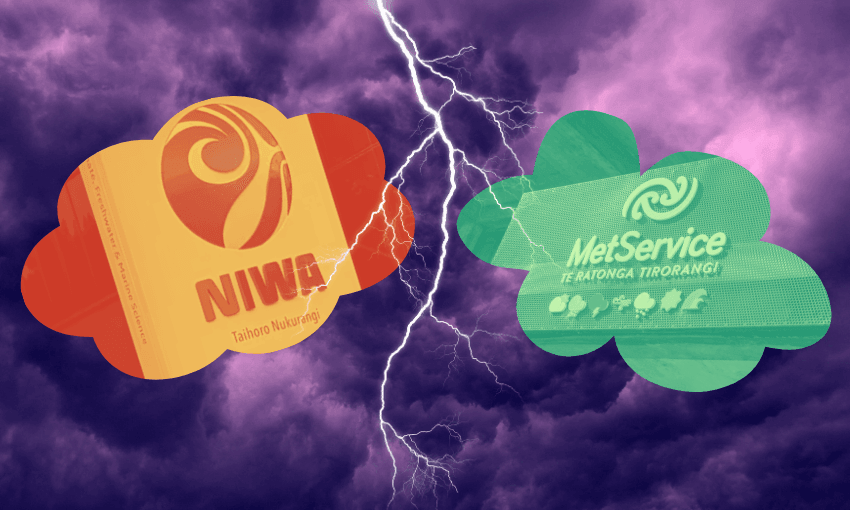Weather forecasts in New Zealand will never be the same, unless you already thought Niwa and MetService were the same thing.
Two national weather watchdogs, both alike in dignity, in a post-Cyclone-Gabrielle Aotearoa, is where we set our scene. From ancient grudge break to a new merger, where climate change makes civil cities unclean. In short, the National Institute of Water and Atmospheric Research (Niwa) is probably going to take over MetService.
On Thursday, science, innovation and technology minister Judith Collins announced that the government was looking to merge the two taxpayer-funded weather entities, in the name of a stronger forecasting system for Aotearoa. Recommended by the Weather Forecasting System Review, the merge would “allow us to better prepare for, and respond to, severe weather events”, said Collins.
You may be thinking, is nothing sacred? Sure, our nation’s response to extreme weather events can be pretty appalling. Sure, Niwa and MetService often present conflicting temps and weather reports. But has anyone asked those poor souls whether they’re actually keen to bunk with each other, given their frosty history?
Let’s retrace our steps: 32 years ago, the Meteorological Service was split in two, birthing Crown research entity Niwa to track long-term weather patterns and climate change, while state-owned MetService remained as the official weather forecasting authority. Somewhere down the line, Niwa decided they’d be a voice for forecasts, too.
The source of the tension may have begun in a library, according to journalist and science writer Paul Gorman. “A lot of the books in the old MetService library, they had to decide which would go to Niwa, which would go to MetService, so it was quite a difficult split,” he told The Detail in 2023. “But it was always quite a clear-cut distinction. And yet at some stage, Niwa said on the record that weather forecasting was always part of its game.”
Thus a decades-long cold front over who had the more accurate weather forecasts. As well as old books, Niwa received Aotearoa’s first weather supercomputer (named Kupe) in 1999, though MetService was unable to access its data for a decade (despite weather forecasting being its job).
In January 2007, the government brought in a mediator to ease the storm brewing between the entities. The mediation resulted in Niwa and MetService signing an official agreement to work closely together on weather forecasting, and climate and environmental events. However, the agreement did little to break the ice.
“There have been occasions where, if you follow them on Twitter or Facebook, [Niwa] will say ‘Westport had its highest ever temperature today’, and MetService will be tweeting ‘no it didn’t, your record is only five years long, ours has been going for a hundred,’” Gorman said. “It’s kind of diluting the power of having all these weather records, which is what policy and infrastructure and people’s lives are based on – having really robust information.”
In 2022, things came to a head after the Department of Conservation purchased Niwa’s forecasts for use in its parks. This caused MetService to claim its rival’s data was “inappropriate for public safety advice”, briefing the Ministry of Transport (with whom MetService has a contract to provide severe weather warnings) that “Niwa relies on automated forecasts with no intervention from professional meteorologists”.
A year later, following severe weather events, the government commissioned the Weather Forecasting System Review from Sapere research group, to explore how Niwa and MetService could combine their capabilities. Instead of establishing a third, perhaps more evil, state-owned entity, Niwa and MetService have already “agreed in principle” to a merger, according to Collins.
The fact that the merger is framed as Niwa taking over MetService, rather than the other way around, may be more of an Oedipal downfall for the latter than a celebration. After decades of going out of their way to correct Niwa’s data, MetService will now be able to turn around in the office and deliver their criticisms face-to-face.
Yet, despite a sodden start to their relationship, Niwa and MetService appear to have mended fences – online, at least. As recently as May, Niwa referred to MetService as their “friends” on Twitter (no reply from MetService, so who knows if the feeling is mutual), and they’re probably beyond reaching mediator point again.
I’ll let this text from a friend sum up how these astronomical changes in weather forecasting will upset the status quo in New Zealand: “Devistated [sic] Metservice and Niwa are merging 😞.” Never has the use of the word “devistated” – clearly felt so deeply that there was no time to spell check – and a subsequent sad emoji face so accurately and succinctly summed up a tragedy such as this. But, if we want better responses to severe weather events, it’s probably needed.



